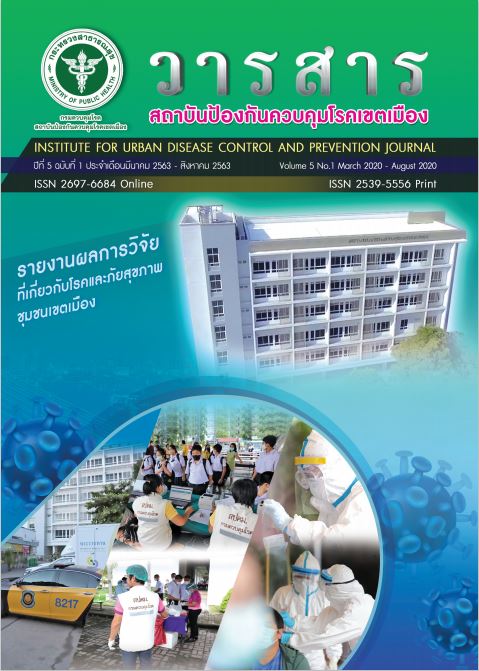การศึกษาความคงสภาพของยาเตรียมเฉพาะราย Dexamethazone Eye Drop สูตรปราศจากสารกันบูดด้วยไฮเปอร์ฟอร์มานซ์ลิควิดโครมาโตกราฟี
Main Article Content
บทคัดย่อ
ผลิตภัณฑ์ยาเตรียมเฉพาะรายDexamethazone Eye Dropสูตรปราศจากสารกันบูดมีความจำเป็นสำหรับผู้ป่วยที่มีข้อห้ามใช้สารกันบูดการศึกษานี้มีวัตถุประสงค์เพื่อทราบถึงความคงสภาพทางกายภาพ, ชีวภาพและเคมีของผลิตภัณฑ์ที่เมื่อจัดเก็บในอุณหภูมิต่างกัน ทำการศึกษาแบบ Quasi-Experimental Researchโดยแบ่งผลิตภัณฑ์ 30 ขวดเป็น 2 กลุ่ม แยกเก็บในตู้เย็น (2-8°C) และอุณหภูมิห้องปกติติดตามลักษณะทางกายภาพ,ความเป็นกรด–ด่าง,ความปราศจากเชื้อในวันที่ 0,7,14,21,30และวิเคราะห์ปริมาณตัวยาDexamethazone ด้วยวิธี HPLC ในวันที่ 0,14,21,30การวิจัยนี้พบว่าผลิตภัณฑ์ที่เก็บในตู้เย็น (2-8°C)และอุณหภูมิห้อง ( 31.5±2.1°C) ยังคงเป็นสารละลายใส ไม่มีตะกอน ไม่มีสี ไม่มีกลิ่น เช่นเดิมจนถึงระยะเวลา 30 วันนับจากวันผลิตค่า pH ทั้งหมดที่วัดได้ในวันที่ 0, 7, 14, 21 และ 30อยู่ในช่วงมาตรฐานตำรับยาตากลุ่มที่เก็บในตู้เย็น(2-8°C)มีค่าเฉลี่ย7.18±0.05, 7.18±0.80, 7.27±0.08, 7.32±0.08, 7.21±0.05ตามลำดับและกลุ่มที่เก็บในอุณหภูมิห้องปกติ ( 31.5±2.1°C) มีค่าเฉลี่ย7.28±0.02, 7.43±0.49, 7.28±0.11, 7.37±0.09, 7.38±0.10 ตามลำดับโดยในวันที่ 30 ค่าเฉลี่ย pH มีความแตกต่างอย่างมีนัยสำคัญทางสถิติ(p-value=0.007) และจากการสุ่มชักตัวอย่างเพื่อส่งเพาะเชื้อแบคทีเรียในวันที่ 0,7,14,21,30ไม่พบการเติบโตของเชื้อในทั้งสองกลุ่มผลิตภัณฑ์ที่จัดเก็บที่อุณหภูมิต่างกัน สำหรับการวิเคราะห์ด้วยวิธี HPLC พบว่าผลิตภัณฑ์ที่เก็บในตู้เย็น(2-8°C)มีปริมาณตัวยาผ่านมาตรฐานที่90.0–115.0 % Labeled amountทุกขวดในวันที่ 0,14,21,30 ค่าเฉลี่ย% Label amount ของตัวยาDexamethazoneคือ104.00±3.61, 101.67±1.15, 102±1.73, 103±7.00 ตามลำดับส่วนที่จัดเก็บอุณหภูมิห้องปกติ ( 31.5±2.1°C) มีปริมาณตัวยาผ่านมาตรฐานทุกขวดเฉพาะในวันที่ 0,14และ 21ค่าเฉลี่ย %LabelamountของตัวยาDexamethazone คือ 104.±4.73,105.00±5.57,99.33±0.58 ตามลำดับ ส่วนในวันที่ 30ผลิตภัณฑ์มีปริมาณตัวยาต่ำกว่ามาตรฐานจำนวน 1 ขวด จึงไม่ผ่านเกณฑ์ยอมรับการสุ่มชักตัวอย่าง สรุปได้ว่าผลิตภัณฑ์ยาเตรียมเฉพาะราย Dexamethazone Eye Drop สูตรปราศจากสารกันบูดที่จัดเก็บในตู้เย็น (2–8°C) มีความคงสภาพทางกายภาพชีวภาพและทางเคมีในเวลา 30 วัน ส่วนที่จัดเก็บในอุณหภูมิห้องปกติ (31.5±2.1°C) มีความคงสภาพทางกายภาพ ชีวภาพ ในเวลา 30 วัน แต่มีความคงสภาพด้านเคมีเพียง 21 วัน ผลิตภัณฑ์จึงมีระยะเวลาการใช้งาน (Beyond-Use Date, BUD) 30 วันเมื่อเก็บในตู้เย็น (2–8°C) และ 21 วันเมื่อเก็บในอุณหภูมิห้องปกติ (31.5±2.1°C) และควรศึกษาต่อไปถึงความคงสภาพด้านความปราศจากเชื้อของผลิตภัณฑ์ในสภาวะแวดล้อมจริงเมื่อผู้ป่วยนำยากลับไปใช้เองที่บ้าน
Article Details
บทความที่พิมพ์ในวารสารสถาบันป้องกันควบคุมโรคเขตเมือง ถือว่าเป็นผลงานวิชาการ งานวิจัยและวิเคราะห์ ตลอดจนเป็นความเห็นส่วนตัวของผู้เขียนเอง ไม่ใช่ความเห็นของสถาบันป้องกันควบคุมโรคเขตเมือง หรือคณะบรรณาธิการแต่ประการใด ผู้เขียนจำต้องรับผิดชอบต่อบทความของตน
เอกสารอ้างอิง
2. วนิดา จีนศาสตร์. มลพิษอากาศและการจัดการคุณภาพอากาศ. กรุงเทพฯ: จุฬาลงกรณ์มหาวิทยาลัย; 2551:28-146.
3. กรมควบคุมโรค กระทรวงสาธารณสุข.ระบบเฝ้าระวัง 5 โรค 5 มิติ. นนทบุรี: บริษัทฮีซ์ จำกัด ;2557.
4. American Academy of Ophthalmology.บทสรุปเกณฑ์มาตรฐานของแนวทางปฎิบัติทั่วไป.Thai-Summary benchmarks-2013[internet].2013[วันที่สืบค้น 24 สิงหาคม 2562]. Available from:https://www.aao.org/Assets/
480a5654-b6a2-449e-8e54-aac93498df19/635116445677530000/thai-summary-benchmarks-2013-pdf
5. KulakarniPS. Steroids in ocular therapy. In:Kooner KS, Sharir M, editors. Textbook of ocularpharmacology. Philadelphia Lippincott-Raven; 1997: 64.
6. Baum JL. Antibiotic use in ophthalmology. In: Duane TD, ed. Clinical Ophthalmology. Philadelphia: Harper&Row ;1986:1-20.
7. Rajpal RK, Glaser SR. Antiseptics and Disinfectants. In: Kooner KS, Sharir M, editors. Textbook of Pharmacology. Philadelphia: Lipppincott-Raven; 1997: 662-3.
8. Prabhasawat P, Chotikavanich S, Leelaporn A. Sterility of Non-Preservative Eye drops. J Med AssocThai ;2005,88(9):6-10.
9. ราชบัณฑิตยสถาน. ศัพท์เภสัชศาสตร์ ฉบับราชบัณฑิตยสถาน พิมพ์ครั้งที่ 2(แก้ไขเพิ่มเติม) พ.ศ. 2549.กรุงเทพฯ:บริษัทด่านสุทธาการพิมพ์ จำกัด ;2549.
10. Jackson M, Lowey A. Handbook of Extemporaneous Preparation. A guide to pharmaceutical compounding. London: Pharmaceutical Press; 2010:447.
11. คณะกรรมการแห่งชาติด้านยา.เภสัชตำรับโรงพยาบาล พ.ศ. 2549.กรุงเทพฯ: โรงพิมพ์ชุมนุมสหกรณ์การเกษตรแห่งประเทศไทย; 2549.
12. Perry HD, Donnenfeld ED. Issues in the use of preservative-free topicals. Manage Care; 2003:39-41.
13. T.Tantayakom, T.Thammikasakul, S.Thunyahan. The sterility of hospital preparation eye drops in stored room temperature. London: European society of cataract and refractive surgeons. 2014.[วันที่สืบค้น 2 พฤษภาคม 2562]. Available from: http://www.escrs.org/London2014/programme/posters-details.asp?id=20539
14. อรวรรณ จิตรวาณิช.ความคงสภาพของยาเตรียมเฉพาะคราวในรูปแบบต่างๆ (Stability of extemporaneous preparations in various dosage forms) [internet] . [วันที่สืบค้น 24 กุมภาพันธ์ 2562]; Available from : https://www.scribd.com/document/407067752/ความคงสภาพของยาเตรียมเฉพาะคราวในรูปแบบต่างๆ
15. United States Pharmacopeia Convention.The United States Pharmacopeia 37 – The National formulary 32.Washington D.C:Rockville; 2013:301-308.
16. United States Pharmacopoeia Convention. Thirty - Ninth Revision, and The National Formulary, Thirty -Fourth Edition and Supplements. Washington D.C:Rockville;2016.
17. British Pharmacopoeia commission. British Pharmacopoeia 2016;1–5:452-656.
18. Ministry of Public Health. Thai Pharmacopoeia and Reference substance II, Volume I, Part 1 and Supplement; 2005.
19. กระทรวงอุตสาหกรรม. วิธีการชักตัวอย่างเพื่อการตรวจสอบลักษณะเชิงคุณภาพ เล่ม 1 แบบแผนการชักตัวอย่างระบุ โดยขีดจำกัดคุณภาพที่ยอมรับ (AQL) เพื่อการตรวจสอบรุ่นต่อรุ่น.,มอก465เล่ม1-2554;2555:9-18,24-5.
20.United State Pharmacopoeia Convention. The National Formulary (USP 37, NF 32). Washington D.C:Rockville;2014.
21.Snape TJ, Astles AM, Davies J. Understanding the chemical basis of drug stability and degradation. Pharm J [internet] . [วันที่สืบค้น 19 กุมภาพันธ์ 2562]. Available from :https://www.pharmaceutical-journal.com/learning/learning-article/understanding-the-chemical-basis-of-drug-stability-and-degradation/11029512.article
22.United State Pharmacopoeia Convention. The National Formulary (USP32/NF27). United States Pharmacopeial Convention Inc ;2009.
23.Eman Ali SaeedAlghamdi, AbdulmalikYahya Al Qahtani,Mazen M. Sinjab. ASHP Guidelines on Pharmacy-Prepared Ophthalmic Products.Best Practices for Hospital & Health-System Pharmacy 2013-2014:114-5
24.ธีรชาติ ชีวาดิศัยกุล และดนุช ปัญจพรผล. การพัฒนาและตรวจสอบความถูกต้องของวิธีวิเคราะห์ความคงตัวด้วย UV-Visible Spectrophotometer ของยาหยอดตาเฉพาะคราว Methylprednisolone. วารสารวิชาการสาธารณสุข 2562;28(4):744-754


